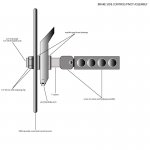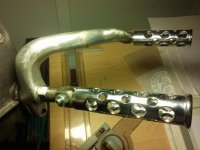vanguard machine
Stainless
- Joined
- Dec 20, 2011
- Location
- Charleston and NYC
trying to figure out what would be the best way to finish this brake lever/foot control assembly for an MC.
Typically i would use a bronze bush here and cut circlip grooves into the main shaft but this is a bit of a reverse engineering thing for a customer using supplied parts.
problem is the peg is threaded onto the shaft and of course would lock down onto the shoulder of the bushing locking it up, of course needs to rotate freely to engage the linkage with master cylinder.
I was thinking a set of thrust bearings on either side of the pivoting arm would be ideal but seeing as how i'm unfamiliar with thrust bearings i figured i would throw it out here for help with the design.
i sketched up a simple drawing to explain what i mean and attached a pic of assembly
open to any suggestions as long as it involves using the customers supplied pivoting arm and peg.
thanks everyone


Typically i would use a bronze bush here and cut circlip grooves into the main shaft but this is a bit of a reverse engineering thing for a customer using supplied parts.
problem is the peg is threaded onto the shaft and of course would lock down onto the shoulder of the bushing locking it up, of course needs to rotate freely to engage the linkage with master cylinder.
I was thinking a set of thrust bearings on either side of the pivoting arm would be ideal but seeing as how i'm unfamiliar with thrust bearings i figured i would throw it out here for help with the design.
i sketched up a simple drawing to explain what i mean and attached a pic of assembly
open to any suggestions as long as it involves using the customers supplied pivoting arm and peg.
thanks everyone




